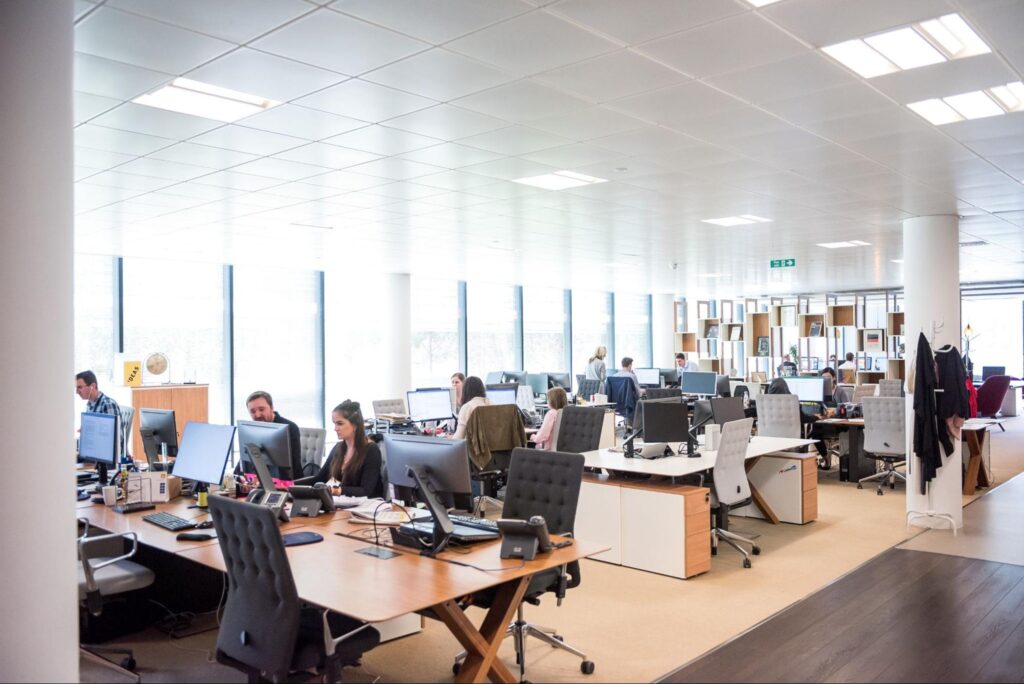Have you ever been in a situation where you are trying to get work done, but there is just so much noise around you that you can’t fully concentrate? Or do you just not feel like you have speech privacy in your space?
Sound masking is the perfect solution to any environment with noise or speech privacy as an ongoing issue! You might be asking yourself, “What is sound masking? Is it the same thing as noise canceling?” We’ll dive into these very common questions below.

According to Cambridge Sound, Sound masking is the process of adding background sound to reduce noise distractions, protect speech privacy and increase office comfort. The background noise typically is an ambient sound engineered to drown out unwanted sounds and protect speech privacy, which encourages the noise you want to hear, whether that is another person, music, a video, etc., and helps you feel more secure when speaking.
A great example of sound masking noise is when you are doing the dishes and conversing with someone, but the sound of the running water drowns out their voice. Another example could be when you’re walking down the street on a phone call, but a noisy truck drives by, and your voice gets masked over the phone.

Sound masking and noise canceling are not the same, even though many believe they are. Sound masking is the addition of a new noise created to mask unwanted noise, while noise-canceling uses certain technologies to completely cancel out noise without adding new noise. They aim for a similar result but are engineered differently.
People also often ask if sound masking is the same as white noise, which it is not. White noise typically is loud and resembles static of some sort, which can become irritating fairly quickly, while sound masking is meant to mimic human speech frequency, creating a pleasant noise that most people don’t even recognize is being emitted.

In a workplace setting, there is nothing worse than disruptive noise while attempting to get work done, which is why sound masking is the perfect option in a work environment.
When it comes to employees' biggest concerns in the workplace, 28% said excessive noise was their biggest concern, and the other 68% said speech privacy was their main concern. A sound masking system can control both of these typical disruptions in an office, making it a great option for businesses to help employees feel more comfortable. It also has shown that sound masking in the workplace increases productivity by a minimum of 2-4%!
Places in a workplace setting where office sound masking is effective:

Sound masking is the perfect solution to a noisy library or study room by drowning out unwanted distractions. Minimizing distractions in an educational setting is important, as students are less productive in a space with constant interruptions.
Places in an educational setting where sound masking is effective:

Hospitals are another important place to implement sound masking due to high patient volumes and overnight services. A hospital is full of noise, and patients are worried about their privacy, so sound masking is a great solution when helping patients feel safe and comfortable during their stay.
Hospitals with a sound masking system installed give their patients the ability to sleep better and recover more quickly. It also helps enhance patient privacy, which is important in a hospital setting.
Places in a hospital setting where sound masking is effective:
In most instances, sound masking speakers are installed above the ceilings in the space to keep them out of sight and are typically placed 15 feet apart. The exact spacing depends on numerous factors within the space they are being installed, such as ceiling tile thickness, the height of the ceiling, space above the ceiling, etc., and these factors also dictate what frequency and volume of sound is emitted from the sound masking speakers.
These speakers can either be installed facing toward the office space, which is direct sound masking, or facing away from the office space, which is indirect sound masking.
The difference between the two types of sound masking besides the direction of the speakers is that with direct sound masking, there typically is less of a need for tuning of the speakers, while indirect masking usually requires a more intense installation, as the sound is meant to hit above and bounce back towards the space, and tuning is crucial to make sure the noise is pleasant and effective.
Here at Workplace Integration, we specialize in creating workspaces that fit your needs, and if you think a sound masking system would benefit your working environment head to our website now and fill out our inquiry form!